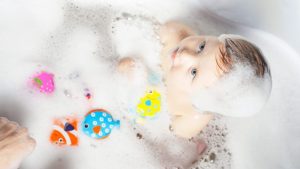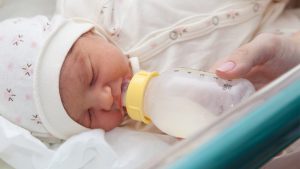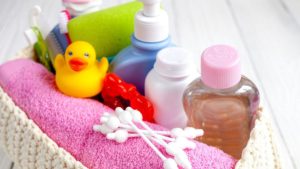
Did your little one open their eyes to this world with a thick head of hair? Or did they do it with a gleaming scalp? It doesn’t matter. Some babies are born with quite a bit of hair, while others do not have much or at all. Hair at birth could be linked to lingering pregnancy hormones. Once these hormones fade away, it is pretty common for the baby and even the mum to lose some hair due to the normalization of endocrinal functions.
Some babies are genetically programmed to shed a large number of hair follicles at the same time. This is called ‘Telogen,’ which should not be a major concern for you as a parent. The hair will grow back, and it may be surprisingly different. How so? It can either be of a different colour, a different thickness, a different texture and shape. After your baby coos into their third month, they will start to grow permanent hair. But this could start as late as 18 months old on some babies, so don’t worry if it doesn’t happen immediately. But you can always consult a pediatric dermatologist if you feel concerned or worried.
Regardless, this is a minor complication, and we can assure you that their hair will grow eventually and keep growing for life.
However, like any other aspect of taking care of your baby, proper hair care is mandatory if you want your baby’s hair to remain healthy and strong. So once your baby’s permanent hair is in play, do you know how to take care of it?
Yes? No? Maybe?
Whatever your answer may be, let us guide you through the dos and don’ts of baby hair care, along with a few expert tips to ensure that your baby grows up to have the healthiest hair possible.
Don’t Be Afraid to Shampoo

One of the main reasons your baby has thin or weak hair as they grow would be a sweaty and dirty scalp. To avoid this, you should be sure to shampoo your baby’s hair and massage the scalp. Before shampooing, you should ensure that you have purchased the right product. Adult shampoo can be mildly toxic to infants, but that should not be a risk you are willing to take. Use a baby shampoo instead. You can also use a head-to-toe multipurpose product to achieve the same results. For best results, shampoo your baby’s hair three times a week. Do not wash your baby’s hair every day as you need their scalp to retain enough moisture and natural oils. Buy a tearless shampoo as it won’t hurt your little one’s eyes even if it trickles down through them.
Massage to Improve Circulation
Use a natural oil product such as coconut oil, olive oil, or a specific oil manufactured for infants, and massage your baby’s entire body, including the scalp. Massaging their scalp has proven to improve blood circulation to the hair pores and would relax them into a nap, which is always crucial. Massaging your baby’s scalp would prevent the scalp from being dried out, retain moisture, and effectively prevent dandruff formation. When massaging your baby, it is essential to be gentle. Apply oil gently to their scalp and massage it without applying any pressure. Use a circular motion for best results. A gentle head massage is an excellent way for you and your baby to bond. Take your time to enjoy these few months while your baby’s hair is short and soft before the time arrives for their first-ever haircut!
Use a Comb

Combing is a century-old remedy that stimulates the hair pores and follicles to function well and aids in the healthy growth of sebum. Sebum is an oily, waxy substance produced by your body’s sebaceous glands, essential to maintaining healthy hair. As it is with massaging, make sure that you do not apply any pressure when combing your baby as their scalp is extremely sensitive. The best comb to use is one with large teeth or a comb with soft bristles. As a healthy practice, comb your baby’s hair once or twice per day. As it is with everything, use moderation.
Manage Cradle Cap Properly

Cradle cap occurs when there is an excess production of sebum. When your baby gets a cradle cap, it would resemble thick yellow and white scales on the scalp. Once again, do not panic if this happens because it goes away naturally when your baby is 8 to 12 months old. To properly manage cradle cap, follow the tips we have given above. Regularly wash and comb your baby’s scalp and keep it as clean as possible. Avoid using any talcum powder on their head when this situation persists.
Trim or Shave, It’s Your Choice!
To maintain healthy hair at an early age, trimming the hair ends regularly would work wonders. Trimming effectively solves issues such as split ends, dandruff, and other dryness-related issues. In terms of comfort for the baby and convenience for the parents, a shorter length mane would be quite helpful.
Yet another way that you could avoid these hair-related issues is by removing hair from the equation. You couldn’t ask for a better deal in terms of convenience, comfort, and time management. However, it is your baby, and it is your choice. Choose the method that most fits your lifestyle and preferences.
Moisturize!
Especially in a case where your baby is bald, use moisturizer to mitigate all dryness-related issues on your baby’s scalp. Using a proper baby moisturizer would ensure that the scalp remains soft, smooth and acts as a shield against dandruff by preserving the moisture from within.
Always Choose Baby Products

When implementing any of the tips we gave you, be mindful not to purchase any adult products. Your shampoo, moisturizer, comb, and other hair care products should be exclusively made for infant care or should be products that are proven to be harmless for babies. (Consult with your Doctor) Baby products are specifically designed to protect a baby’s sensitive skin from irritation or external harm.
Long Hair Comes with Extra Care
If you let your baby’s hair grow out, you should take extra precautions in comparison to a parent handling a baby with short hair. You should regularly trim, oil, and clean their hair to avoid any damage. When oiling their scalp, do not leave it on for a long time as it would invite dirt and dust to stick onto their hair. When using headbands or clippings, do not use tight ones and avoid restraining the baby’s hair too much. Remember! Your baby is a baby, and they may not be able to communicate the pain or discomfort that they may experience. You must be mindful and keep your baby as comfortable as possible. If your baby’s hair gets tangled by any chance, use a baby-friendly conditioner, and untangle it easily!
You should know that taking care of a baby’s hair is even easier than taking care of an adult’s hair. Although we ran you through some specific scenarios and precautionary measures, do not be intimidated! Relax and always use your instincts. If you have any suspicions that are not easily resolvable, consult your doctor immediately. Always make eye contact with your baby if they act distressed and calm them down by singing a soothing song or showing affection. Now, go on and make hair care an enjoyable experience for you and your baby. Just relax, you’ve got this!

Leave a Reply